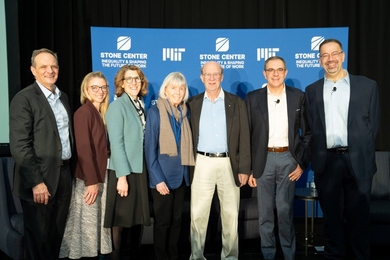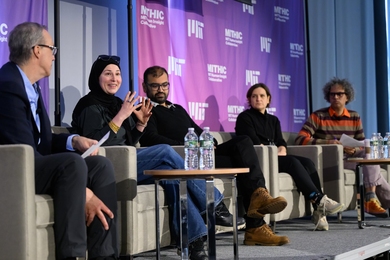Alexander Dreyfoos, president of Photo Electronics Corp. (PEC) of West Palm Beach, FL, has committed $15 million towards construction of a complex of buildings that will serve as a new center for computation, information and intelligence sciences at MIT.
"I am delighted to be able to announce this superb gift from Alex Dreyfoos for a facility within a new group of buildings to house the intelligence sciences," said President Charles M. Vest.
The Dreyfoos facility will include the Artificial Intelligence Laboratory, the Laboratory for Information and Decision Systems, the Department of Linguistics and Philosophy, and some portions of the Department of Brain and Cognitive Sciences.
Frank Gehry, who designed the titanium-clad Bilbao Museum in Spain, is the architect of choice, and the initial programming and design are underway. The complex, containing more than 300,000 square feet, will replace Building 20. The entire complex is to be named for Ray and Maria Stata
12 YEARS ON CORPORATION.
Mr. Dreyfoos, who graduated from MIT in 1954, has been a member of the MIT Corporation since 1986. He is also a member of the Corporation Development Committee and chairman of the Architecture and Media Arts and Sciences Visiting Committee. He contributed in the spirit of "giving something back," he said in a recent interview.
"I was a borrower as an undergraduate. I recall wondering if I would ever be able to pay it back," he said. "Back then, there was no UROP (Undergraduate Research Opportunities Program). The important thing is, I was able to go to MIT when I did not have the means."
Mr. Dreyfoos has achieved far more than repaying old loans since his student days. In addition to founding PEC, he holds 10 US patents, and he invented the Professional Video Analyzing Computer, a machine used by color labs to make high-quality prints, which is marketed worldwide by Eastman-Kodak. An earlier version, the Video Color Negative Analyzer (VCNA) is on permanent display in the Smith-sonian. PEC won an Academy Award in 1971 for developing a motion-picture video analyzer.
Mr. Dreyfoos believes the fruits of success should never obscure the route to success, and he credits MIT with inspiring and guiding him towards the rewarding -- even adventuresome -- life he enjoys today.
"Somebody was generous before me," he commented, noting that such generosity included a far-reaching intellectual challenge from Professor of Physics Arthur Hardy in 1951.
"Professor Hardy said, 'Those who would be successful in the future would be those who could combine disciplines,'" Mr. Dreyfoos recalled. "Hardy knew that electronics would play an important role in the future of photography, and took it upon himself to show me. 'If you understand photography and electronics together,' he said, 'you'll be able to do creative things.'"
Mr. Dreyfoos then began to study electronics, optics and physics. Later he went to Harvard Business School. "It was just wonderful that I ran into Hardy," Mr. Dreyfoos said. "He had a profound impact on me."
Mr. Dreyfoos moved PEC to West Palm Beach in 1969, inspired by the discovery "that you could vacation and work in the same place."
Still a resident of West Palm Beach, Mr. Dreyfoos takes that vacation/work mix seriously. He is an Air Transport-rated pilot and owns a Citation V Ultra jet which he flies solo. He and his wife fly across North America for business and pleasure, including trips to MIT.
ARTS ADVOCATE
The same taste for adventure showed up in Mr. Dreyfoos's business life when, in 1973, he bought the CBS-TV station in West Palm Beach and used it to advocate the arts.
"It was the first time I turned away from the oscilloscope and a soldering iron," he said with a chuckle. "Soon, I got curious: could you use a TV station to move a community to do something specific?"
"Something specific" started out simply enough, with Mr. Dreyfoos agreeing to chair a fundraising effort to build a performing arts center. This role led him to found the Palm Beach County Arts Council and to direct a 14-year effort, $63 million fundraising campaign to build a world-class performing arts center. The Raymond F. Kravis Center for the Performing Arts opened in West Palm Beach in 1992.
Mr. Dreyfoos, who is still chairman, said it's ironic because his father, an amateur cellist, and his mother, a professional cellist who studied with Pablo Casals, pushed him to pursue music. As a child he wanted nothing to do with the arts, yet themes of creativity, risk-taking and innovativeness have persisted throughout his life.
In 1995, he established the Alex Dreyfoos Jr. (1954) Career Development Professorship of Media Arts and Sciences, currently held by Assistant Professor Michael J. Hawley.
MIT COMBINATION
"I like what I see going on at MIT," he said, citing "the brightness of the students and the lack of discrimination." Referring to his own interdisciplinary roots ("one foot in one technology and one in another"), Mr. Dreyfoos also commended on "the way MIT encourages innovation and entrepreneurship, as shown in the Bank-Boston study" (MIT: The Impact of Innovation, a 1997 study of the national economic impact of companies founded by MIT alumni/ae).
Mr. Dreyfoos has enjoyed a long-standing relationship with the Media Laboratory and is a friend of Media Lab Director Nicholas P. Negroponte, the Wiesner Professor of Media Technology.
As for the complex that will house so many scientific disciplines, Mr. Dreyfoos said he was excited about the potential for a "major project, done right, leading to more cross-pollination of ideas.
"I hope that the new building will make both an architectural statement and a vista statement that will be to the 21st century what Killian Court was to the 20th century. I hope the vision will be of similar magnitude," said Mr. Dreyfoos.
A version of this article appeared in MIT Tech Talk on March 11, 1998.





